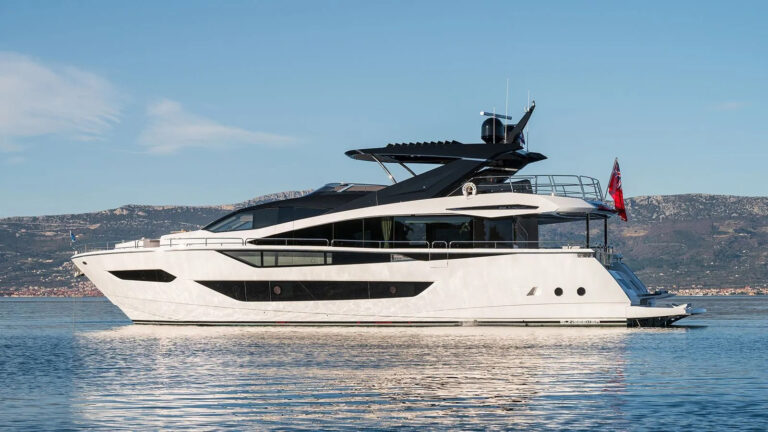Open communication is the key to any healthy relationship, including the one your onboard electronic devices have with one another. This describes the goal the National Marine Electronics Association set for its NMEA 2000 protocol. As though to prove the viability of the new standard, Teleflex developed its MagicBus control area network bus system (CANbus), which digitally connects a series of remote display and control devices. This is the first NMEA 2000 system on the market.
“MagicBus is NMEA 2000,” said Scott Kern, one of Teleflex’s technical gurus and my host during a recent sea trial out of Cape May, New Jersey.
“Plug and play” and “one-touch operation” are the two principal reasons for the existence of MagicBus. The first concept is a function of NMEA 2000’s open architecture; the second is the result of clever design and programming. Plug and play means you may connect any NMEA 2000 device to the bus, and the other devices already interfaced automatically recognize the newcomer’s address and begin to communicate with it. Unlike the NMEA 0183 standard, which requires hard-wiring individual devices to a power source, the 2000 standard lets you plug into the bus via a simple waterproof T-connector. That’s all-you don’t need any additional wiring.
In its simplest form, MagicBus consists of a single cable running throughout the boat from a MagicBox power distributor. The MagicBox connects to the battery and circuit breakers and evenly distributes power to all the devices on the bus. This is how the system eliminates hard-wiring components to the power source. Only the engines and the control heads for shifting and throttle have to be hard-wired to the battery, in this case via a control box for each engine and one each for shifting and throttle.
As you expand the system, you will add a MagicBox or two to handle the amp draw. Though no single passenger on the bus may draw more than 30 amps, each MagicBox is able to cope with a much higher current draw, as large as 79 amps on the company’s Silverton. Regardless of how many items you add to the system, MagicBus’ main line remains a single cable.
The system’s only serious drawback is its inability to carry images. “We don’t see that we will be putting radar information on the bus, Kern said, “just like we’ll probably never put chart plotting information on it. Nevertheless, MagicBus is a treat to use.
The one-button approach works exactly as advertised. A single button drops the engines to idle at 550 rpm to keep the boat within the 6-mph limit of the no-wake zones. After we were up and running at planing speed, we synchronized the engines by matching the levers and pushing a single button to engage the electronic synch mode. A red light shines when the synchronizer is engaged, and one lever becomes a dummy. To exit synch, match the levers and push a button. Bingo. A green light blinks to show the levers aren’t matched; it goes continuous when you match them.
One touch activates the autopilot, too. The A/P takes instructions from the fluxgate compass and a GPS. If you are on a route that you’ve already programmed, the A/P simply follows it, making course adjustments at each waypoint. We traced a loop in Delaware Bay without touching the wheel. Response to the pilot’s output was sharp and quick because the Teleflex i3000 unit learned the characteristics of the boat, anticipating her turns and the speeds. What’s more, you may set the pilot to throttle back when the boat reaches the waypoints, useful if the route requires a tight turn in shallow water, for example.
MagicBus keeps tabs on all the systems aboard-lighting, bilge pumps, freshwater pumps, stereo, navigational systems and more. It does not, however, monitor the genset, nor can it control the stereo’s on/off function. A typical setup at the helm may have the i5000 chart plotter/GPS/fishfinder/engine monitor display, the i5100 Smart Switch panel/display, the i3000 autopilot with its circular one-button control and dodge buttons. MagicBus lets you toggle among all the data riding the bus and display it on the i5000 screen.
The Smart Switch panel lets you control exterior and interior lighting, the volume of the stereo and the master power switch. Kern said Clarion is working with Teleflex to put the stereo’s power switch on the bus, but he couldn’t say exactly when this will happen.
Flexibility of the display is one of MagicBus’ most endearing characteristics. You may set up the display pages in a variety of configurations, depending on which data are most important to you. After you’ve configured your displays, you may program each of them to a series of quick keys. During setup or any time afterward, you press any key to call up a menu. When you retrieve the display you want, you store it by holding in the designated key until you get a “key 1” stored message. You activate the key by going to the system menu and selecting “activate hot key. Our Silverton didn’t have the quick keys activated, but selecting the menus to get the displays was not a problem-at least in calm water.
The buyer may also choose the i2000 serial gauges to complement the i5000 display. These look exactly like analog gauges for the tachometer, speedometer, fuel, oil, volts and temperature, but the input is digital.
Our skipper for the demo is an avid fisherman and likes the convenience MagicBus offers when he changes steering stations. If he wants to drive from the tower station, for example, he merely moves the control levers to match the position of the ones at the helm on the flying bridge, then pushes a button on the control head to engage the new station. He also likes having repeater displays at every helm station.
Right now, anyone who wants to start with a simple system and add components as necessary will appreciate the add-a-pearl nature of MagicBus. Experienced owners who don’t want to be saddled by the exclusive nature of proprietary integrated systems may choose MagicBus for everything except radar. The reduction in the size and complexity of the wiring runs benefits everyone, builders included. MagicBus simplifies installation and reduces maintenance after the boat has been in service for a few seasons.
Contact: Teleflex Marine/Industrial, (610) 495-7011; ; .









